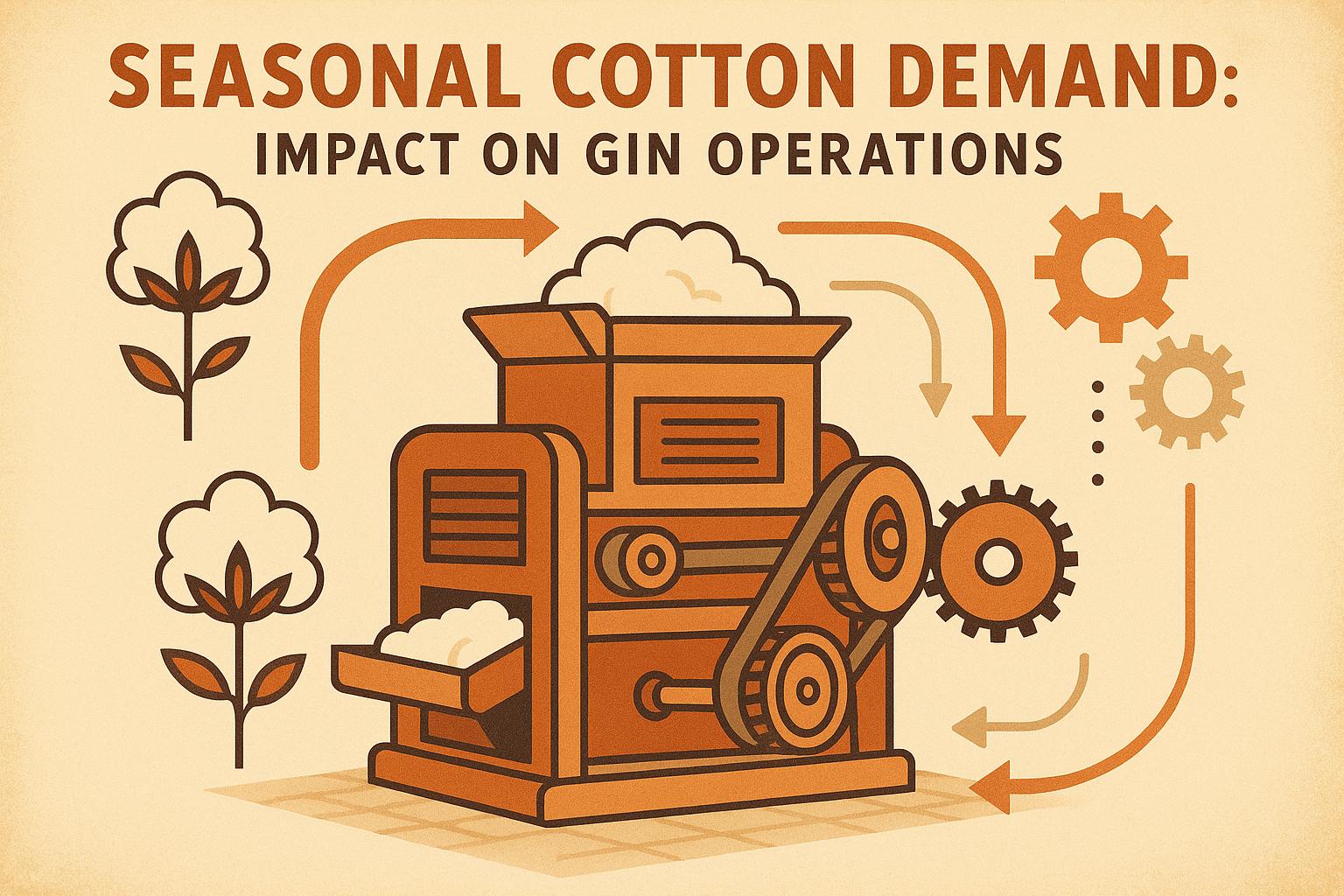Looking for the best cotton market data in 2025? Here's a quick guide to help you choose the right sources for accurate and timely insights. U.S. cotton producers face unpredictable futures, rising costs, and global trade shifts. That’s why choosing the right data source is critical for making informed decisions.
Key Takeaways:
- USDA Economic Research Service (ERS): Monthly, free reports with updated U.S.-focused data. Great for domestic insights but limited on global trends.
- OECD-FAO Outlook: Annual global projections with 10-year forecasts. Ideal for understanding international markets but lacks frequent updates.
- National Cotton Council (NCC): Surveys producers for regional insights. Useful for local trends but less frequent and narrower in scope.
- Georgia Cotton Commission: State-specific reports tailored to Georgia's cotton industry. Offers practical guidance but limited to one region.
- Private Research Firms: Paid services with global data and real-time updates. Broad coverage but costs and transparency vary.
Quick Comparison:
| Data Source | Focus | Frequency | Strengths | Limitations |
|---|---|---|---|---|
| USDA ERS | U.S. market | Monthly | Free, detailed U.S. data | Limited global scope |
| OECD-FAO | Global market | Annual | Long-term global trends | Infrequent updates |
| National Cotton Council | Regional (U.S.) | Annual | Producer-driven, local insights | Narrow focus, less frequent |
| Georgia Cotton Commission | Georgia-specific | Seasonal | Tailored to local conditions | Limited to Georgia |
| Private Research Firms | Global market | Real-time | Global coverage, detailed analysis | Paid access, variable quality |
The bottom line: Blend multiple sources to balance global trends, regional specifics, and timely updates. Whether you're planning acreage, tracking prices, or managing logistics, the right mix of data ensures you stay ahead.
Forecasting Cotton future prices with AI, by Emre Balduk, Founder of cotcast.ai
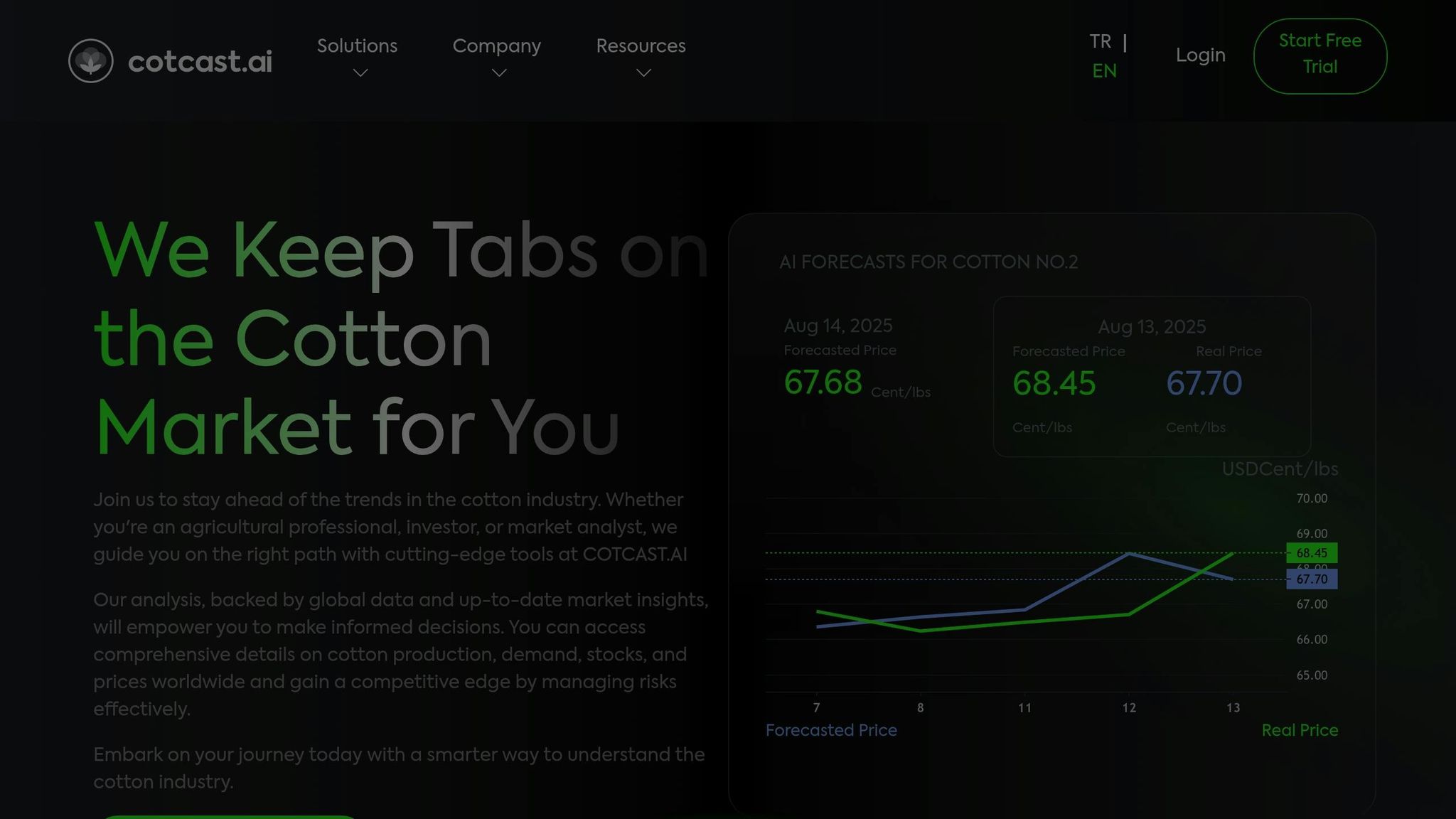
1. USDA Economic Research Service (ERS) Reports
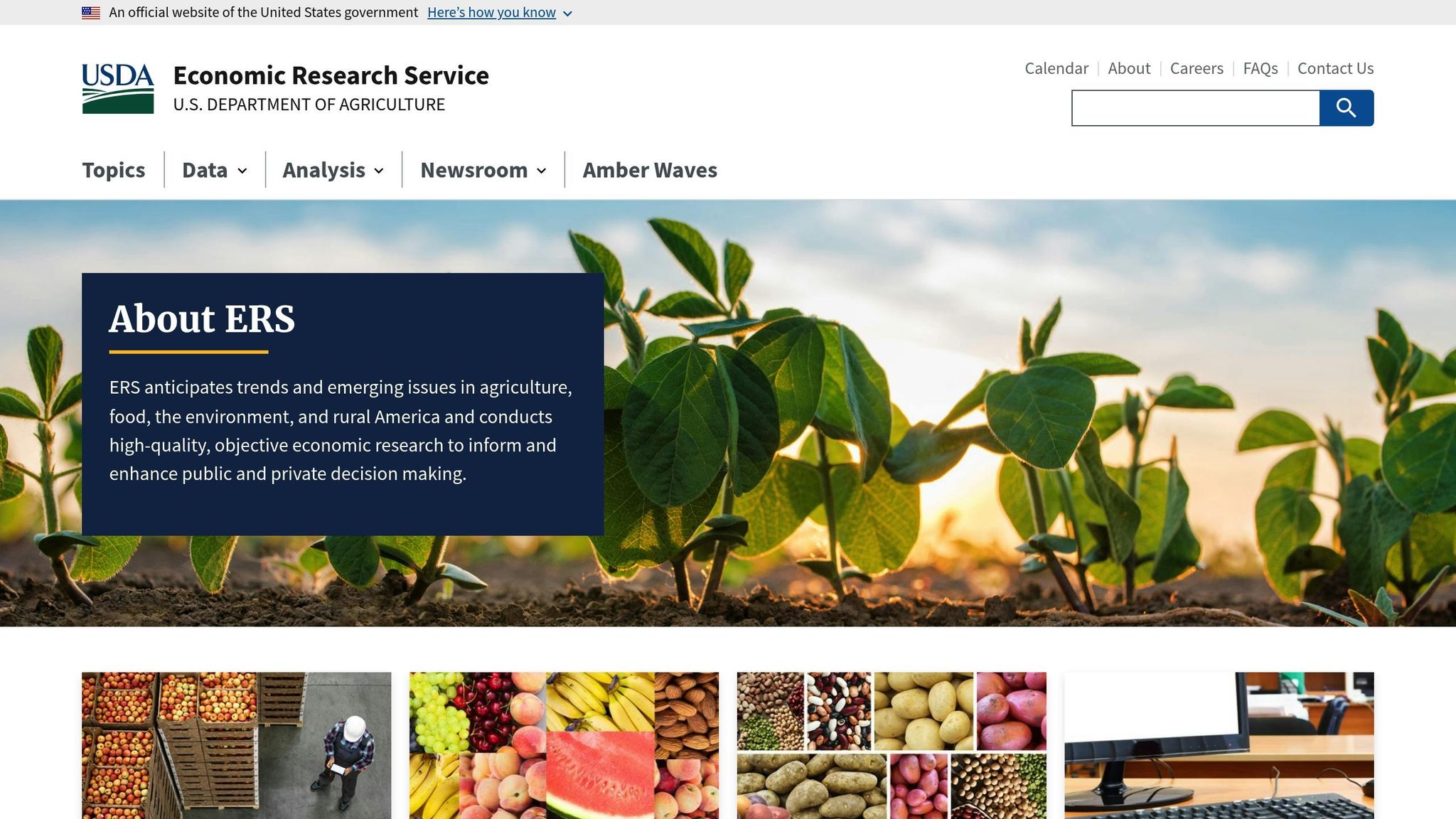
The USDA Economic Research Service (ERS) is a key source for up-to-date cotton market insights. Its flagship publication, the Cotton and Wool Outlook, serves as an essential tool for strategic planning and market evaluation, delivering detailed and precise information.
Data Accuracy
For example, the July 2025 report featured U.S. cotton crop data updated as recently as July 13, 2025. This reflects the ERS's focus on providing the most current and reliable data.
Timeliness
ERS releases its reports monthly, timed to align with critical decision-making periods. Since April 2025, these reports have been consistently published at 3:00 p.m. ET, ensuring timely updates just days before their release.
Accessibility
Accessing ERS reports is straightforward and free of charge through the USDA website. Additionally, producers can subscribe to an email notification service to receive instant alerts when new reports become available.
Future Projections
The reports also include projections for the 2025/26 marketing year, which runs from August to July. These forecasts are invaluable for planning planting schedules and making contract decisions.
2. OECD-FAO Agricultural Outlook
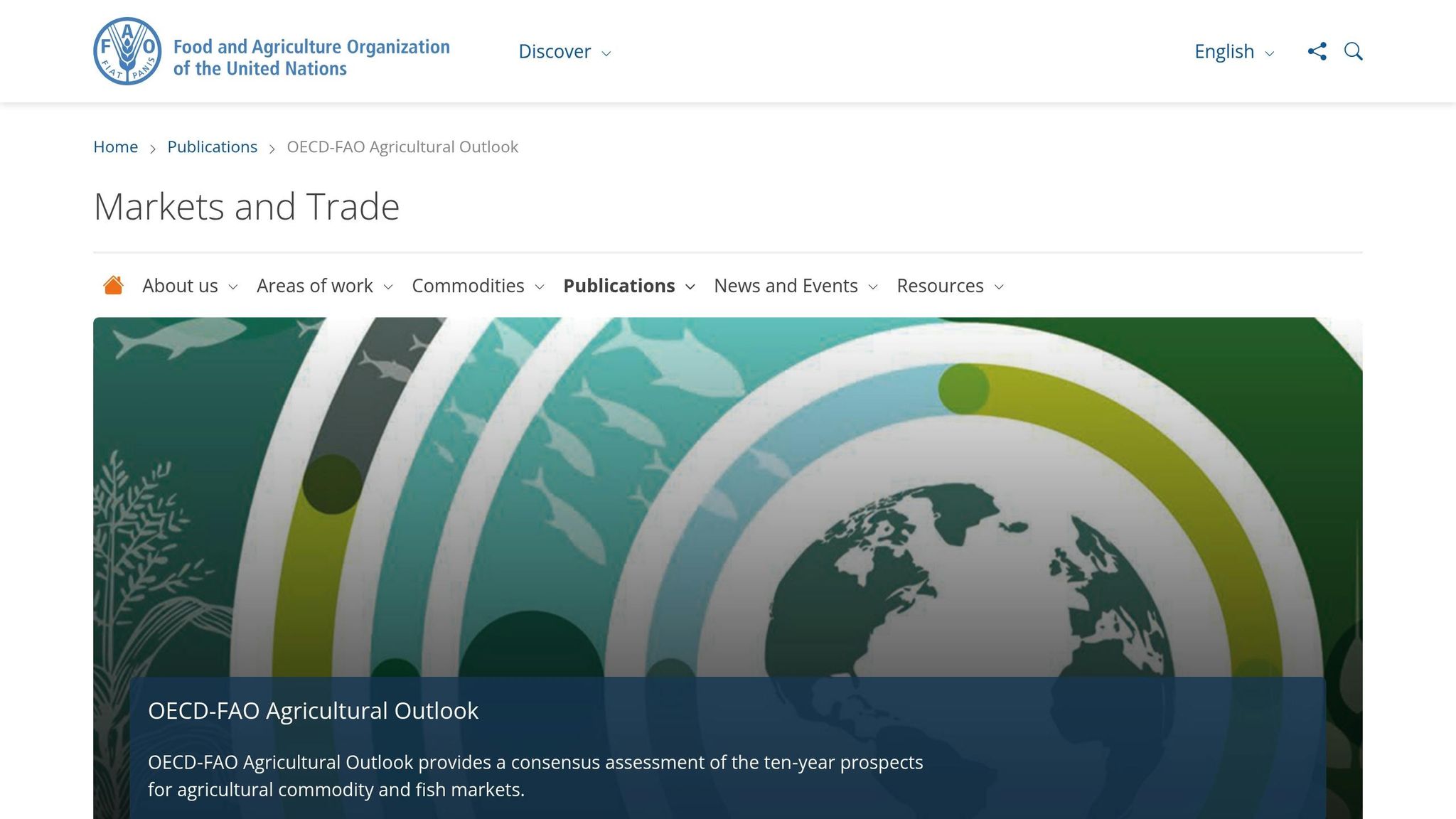
The OECD-FAO Agricultural Outlook offers medium-term global projections for cotton markets. This joint effort provides U.S. cotton producers with valuable insights into their role within the broader global landscape.
Data Accuracy
The 2025–2034 report anticipates a steady annual growth of 1.3% in global cotton production, predicting it will reach 29.5 million tons by 2034. It also notes a recovery in the 2024/25 season after recent challenges.
Timeliness
Published annually on July 15, the report focuses on medium-term market trends. The 2025 edition highlights price movements since Q2 2024, emphasizing a downward trend caused by strong production, weaker global demand, and higher stock levels.
Geographic Coverage
The report places U.S. cotton within a global framework, projecting that by 2034, the U.S. and Brazil will each account for about 30% of raw cotton exports. It also predicts a 1.2% annual increase in global cotton consumption, driven largely by growing textile demand in emerging markets.
Accessibility
Blending up-to-date market analysis with decade-long forecasts, the report addresses short-term issues like the modest rebound in cotton consumption expected in 2024/25 after a contraction in 2022/23. At the same time, it offers long-term insights that help producers and stakeholders strategize effectively. This comprehensive outlook sets the stage for deeper exploration of specialized market surveys in the next section.
3. National Cotton Council (NCC) Surveys and Outlooks
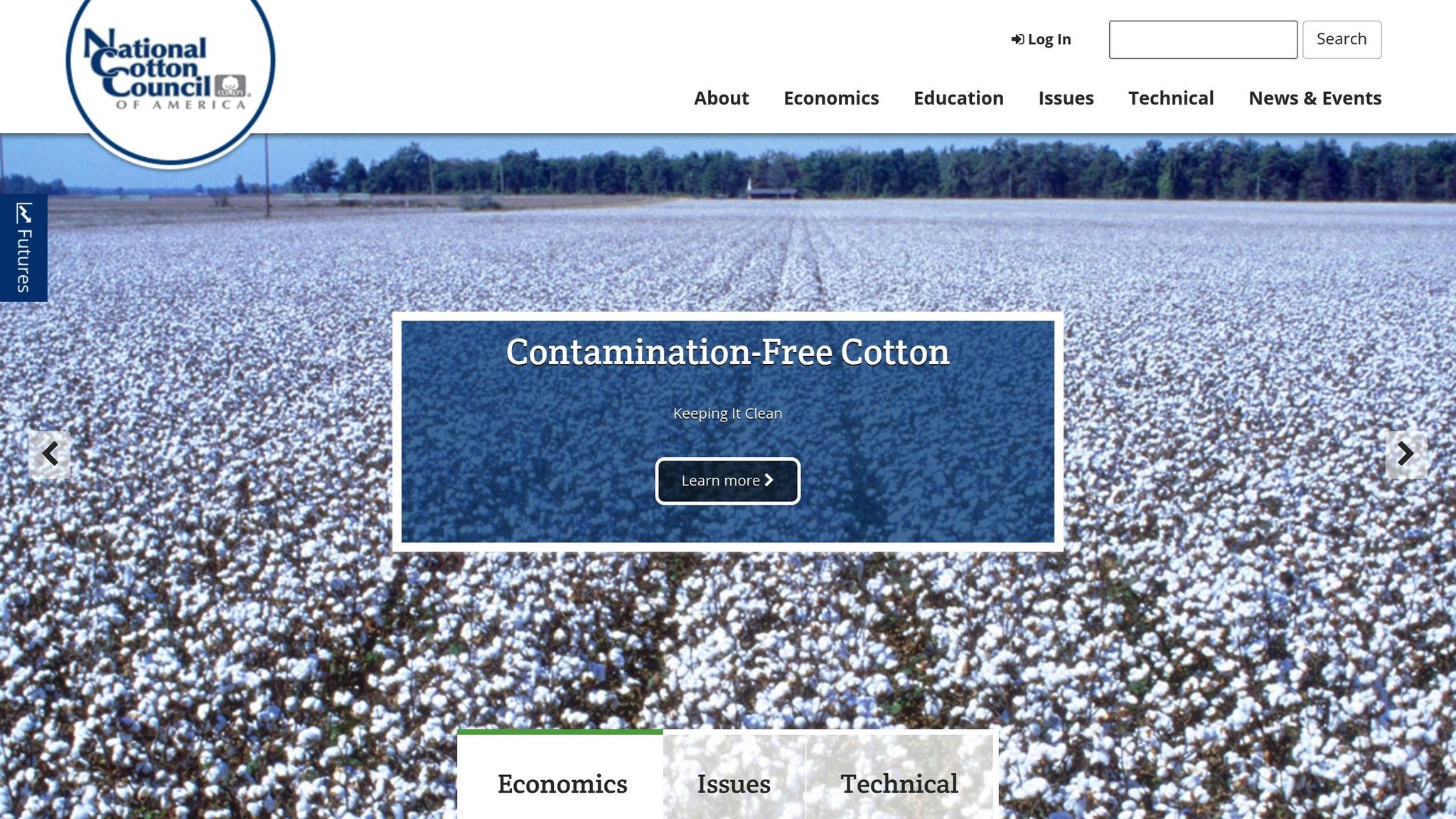
The National Cotton Council (NCC) plays a key role in supporting U.S. cotton producers by conducting focused surveys and providing market outlooks. These efforts center on domestic production trends, offering insights that align with, but also enhance, the broader forecasts from global organizations. What sets NCC apart is its localized, producer-driven perspective, which is critical for making informed regional decisions.
Data Accuracy
One of NCC’s standout tools is the Annual Early Season Planting Intentions Survey, which gathers direct input from producers to create precise projections. For its 44th Annual Survey, U.S. cotton producers shared plans to plant 9.6 million acres in 2025 - a sharp 14.5% drop compared to 2024. This includes 9.4 million acres of upland cotton (down 14.4%) and 158,000 acres of extra-long staple (ELS) cotton (a 23.5% decrease).
Using historical data on abandonment rates and average yields, the survey forecasted a 2025 crop of 13.9 million bales, broken down into 13.5 million upland bales and 392,000 ELS bales. While the survey offers valuable insights, the NCC recognizes its limitations, as noted by Dr. Jody Campiche, Vice President of Economics & Policy Analysis:
"Planted acreage is just one of the factors that will determine supplies of cotton and cottonseed. Ultimately, weather and agronomic conditions are among the factors that play a significant role in determining crop size."
Timeliness
The NCC operates on a well-defined annual schedule to ensure its findings are available when producers need them most. Producers complete surveys in January, with results released on February 16, 2025. This timing provides early-season data, giving producers a clear snapshot of planting intentions before the season begins. However, actual planting decisions may shift due to changing market conditions or weather.
Geographic Coverage
The NCC surveys span 17 states, grouped into four key cotton-producing regions: the Southeast, Mid-South, Southwest, and West. This approach delivers detailed, state-specific insights, empowering producers to understand local planting trends. For instance, the 2025 survey highlighted significant regional variations, including a 21.5% decline in Georgia, an 8.2% drop in the Mid-South, and a 15.8% decrease in Texas. Beyond this, the NCC also provides a U.S. Production Map, which breaks down cotton production by county, offering highly detailed data to aid strategic planning.
Accessibility
NCC survey results are shared during the Annual Meeting and distributed via established industry channels, ensuring they reach key stakeholders. By incorporating direct producer input, the NCC provides a grassroots perspective that complements the top-down forecasts from national and international sources. This combination offers a well-rounded view of market conditions, rooted in the realities faced by cotton producers.
4. Georgia Cotton Commission Market Reports
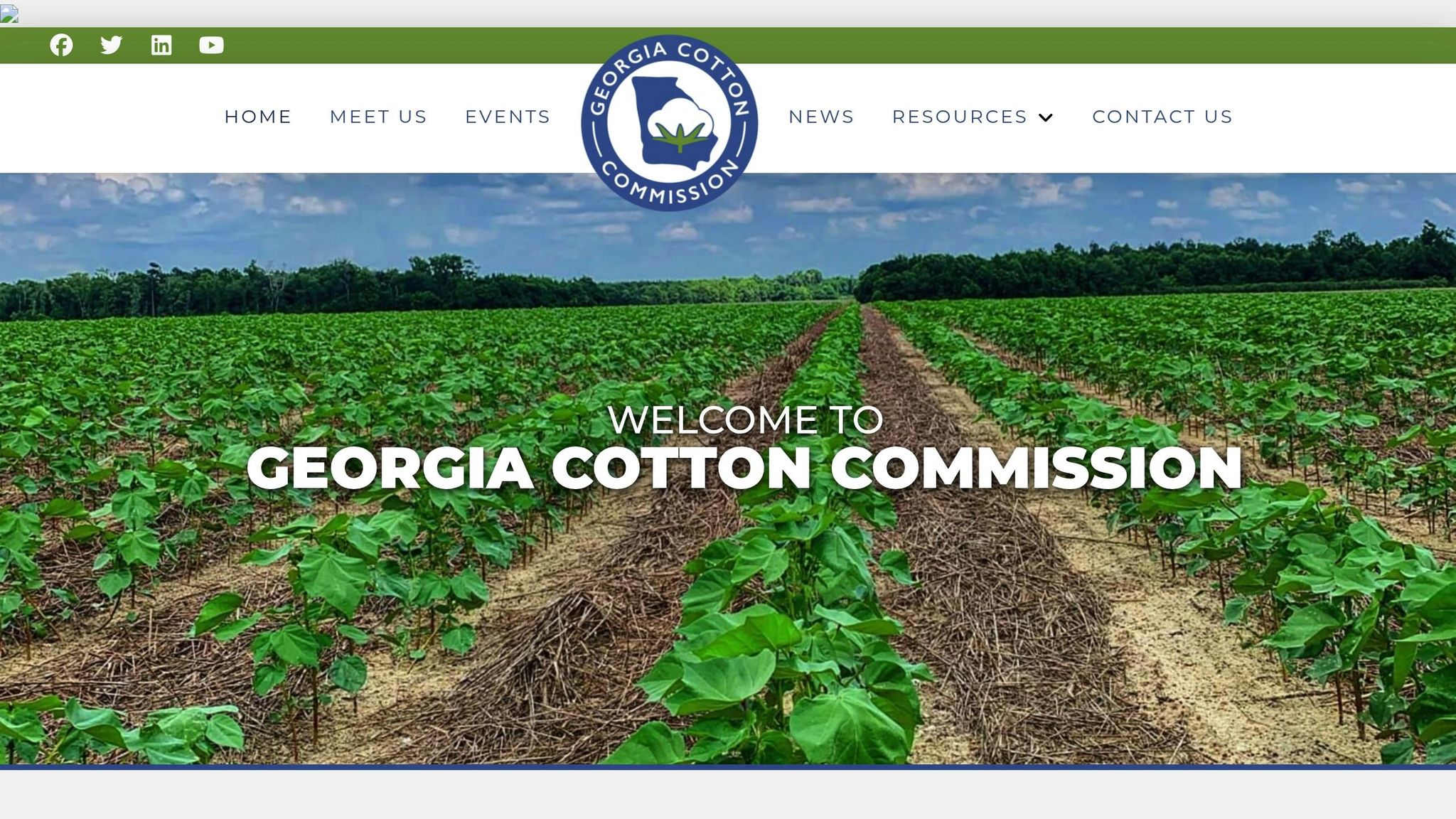
The Georgia Cotton Commission offers market insights specifically designed for cotton producers in the state. By focusing on Georgia's distinct growing conditions, market trends, and regional challenges, these reports provide useful data that help farmers make smarter decisions. While similar to national and global reports, these insights are tailored to the unique needs of Georgia's cotton industry.
Data Accuracy
These reports are created in collaboration with the University of Georgia Extension and local county agents, ensuring they reflect real-world conditions. They track important metrics like planted acreage, yield, and cotton quality. By closely monitoring production volumes and quality grades, the Commission helps shape marketing strategies suited to the region.
Timeliness
The reports are scheduled to align with Georgia's growing season, offering updates during planting, mid-season, and harvest. Early-season reports guide planting decisions, mid-season updates shed light on crop conditions and yield expectations, and harvest reports - released shortly after major harvesting activity - help producers and buyers understand quality trends and market availability.
Geographic Coverage
The Commission structures its reports by grouping cotton-producing counties into regions based on local growing conditions and harvest timelines. This regional focus allows buyers to anticipate market timing and quality differences across the state.
Accessibility
Farmers can access these reports through county Extension offices, local cotton marketing groups, and regional agricultural publications. Additionally, the Commission collaborates with cottongins.org, a directory of cotton gin locations in Georgia. This partnership not only provides market insights but also practical information on processing facilities, making it easier for producers to plan their production and marketing efforts effectively.
sbb-itb-0e617ca
5. Private Market Research Firms
While government and regional reports focus on localized data, private market research firms bring a broader, global perspective to the table. Companies like Cognitive Market Research specialize in analyzing cotton market trends on a worldwide scale. They examine factors like production, consumption, and trade flows across both domestic and international markets.
This wide-reaching analysis helps U.S. cotton producers gain a clearer picture of how global market dynamics could affect local conditions. By pairing these international insights with domestic data, producers can better prepare for shifts in the market driven by global trends.
Advantages and Disadvantages
Every data source comes with its own set of strengths and weaknesses. Understanding these differences helps producers choose the right combination of resources for a complete market picture.
| Data Source | Advantages | Disadvantages |
|---|---|---|
| USDA Economic Research Service | • Updated frequently (latest: 7/16/2025) • High accuracy and backed by government authority • Extensive U.S. market insights • Free access to all reports |
• Limited focus on international markets • Uses complex, technical terminology • Primarily centered on domestic conditions |
| OECD-FAO Agricultural Outlook | • Offers a global perspective with 10-year forecasts • Recently published (July 15, 2025) • Includes international trade flow analysis • Trusted international data source |
• Provides less detail on U.S.-specific trends • Published annually, limiting real-time updates • May not account for sudden market shifts |
| National Cotton Council Surveys | • Provides industry-specific insights • Direct feedback from producers • Practical for market planning • Strong ties to the U.S. cotton industry |
• Narrow geographic focus • Potential for industry bias • Less frequent updates • Smaller sample size |
| Georgia Cotton Commission | • Deep regional expertise • Offers practical advice for producers • Focuses on state-level market trends |
• Data is somewhat dated (December 2024) • Limited to southeastern U.S. markets • Narrow geographic coverage |
| Private Research Firms | • Global market insights • Real-time data availability • Detailed trend analysis • Expertise in international trade |
• Requires paid subscriptions • Data quality varies by firm • Methodologies may lack transparency |
These comparisons highlight the trade-offs involved, helping producers decide how to blend sources for a comprehensive market view.
Timeliness is critical when it comes to planting decisions or negotiating contracts. Geographic coverage also varies widely: the USDA, for instance, focuses on domestic conditions, such as its projection of the U.S. upland cotton farm price for 2025/26 at 62 cents per pound. On the other hand, international sources like the OECD-FAO provide a broader view of global trends.
Ease of access is another factor to weigh. While government reports are free, they often require navigating complex systems. Private firms, though more user-friendly, charge for access.
Ultimately, balancing accuracy with timeliness is key. Government data adheres to strict standards but may be delayed due to formal review processes. Meanwhile, private firms offer quicker updates, though their methods may not always be fully transparent.
Using Local Directories and Data Resources
National and global data sources provide a broad overview, but cotton producers often need more localized insights to make informed decisions. This is where local directories become invaluable, offering details that national reports tend to overlook. These resources complement broader market trends by delivering the specific, actionable information producers need for day-to-day operations.
Cotton ginning operations are a vital part of the supply chain, transforming raw cotton into lint and cottonseed. The efficiency of these operations can significantly influence logistics costs and storage expenses. Knowing the location and functionality of these facilities allows producers to better plan their harvests and marketing strategies, ensuring smoother operations.
The seasonal nature of ginning creates unique challenges. Most cotton gins operate for only one to two months annually, often in rural areas. This short window makes it essential for producers to align their harvest schedules with available gin capacity. A detailed directory of gin locations across counties and states can help producers identify backup options and optimize transportation routes, reducing potential delays.
Geographic proximity plays a big role in controlling costs. Transporting cotton over long distances not only increases expenses but also risks compromising quality. By using local directories to locate nearby ginning facilities, producers can lower hauling costs and maintain the quality of their cotton during transit.
The U.S. ginning network is extensive, with the National Cotton Ginners Association representing around 970 ginning facilities across 17 cotton-producing states. Managing operations within this vast network requires reliable, up-to-date information about these facilities.
Regional market conditions often vary significantly from national averages, making local data even more critical. A well-maintained gin directory that includes detailed location and capacity information helps producers navigate regional constraints and pricing differences. This becomes especially important in years when weather disrupts harvest timing across different areas. By combining national market trends with localized data, producers can adjust their strategies to meet the unique demands of their region.
Having access to updated facility data also supports better logistics and contingency planning. Knowing the location, capacity, and services of gins allows producers to prepare for various scenarios and respond effectively to unexpected challenges.
This combination of local insights and broader market analysis lays the groundwork for more strategic marketing decisions.
Conclusion
As we look ahead to 2025, the USDA remains the go-to source for dependable cotton market data, providing U.S. producers with a wealth of crucial insights. Reports from the Economic Research Service, in particular, serve as a cornerstone for understanding market trends and crafting effective strategies. When paired with both global and regional perspectives, these insights offer a well-rounded foundation for making informed decisions.
By combining global forecasts, regional analyses, and local expertise, producers can create strategies that address market volatility from every angle. For instance, the OECD-FAO Agricultural Outlook offers a valuable long-term global view, while National Cotton Council surveys deliver insights rooted in producer experiences. Meanwhile, regional sources like the Georgia Cotton Commission provide targeted, state-level information. Together, these resources equip producers with the tools they need to stay ahead in an ever-changing market.
Blending USDA data with localized intelligence creates a powerful approach, enabling producers to tackle uncertainty and unlock the full potential of the cotton market in 2025.
FAQs
What are the benefits of using multiple cotton market data sources for decision-making in 2025?
Using a variety of cotton market data sources in 2025 offers a more complete understanding of industry trends and market behavior. By tapping into diverse information channels, cotton producers can stay updated on critical developments - like shifts in global production, rising demand for organic cotton, and new export opportunities. This wider perspective equips producers to make smarter, well-informed decisions.
Cross-referencing data from multiple sources also boosts accuracy and dependability. It helps producers monitor market fluctuations more closely and prepare for potential changes, such as production increases in North America or shifts in trade patterns. Relying on multiple data points is key to staying competitive and managing the challenges of a fast-evolving global cotton market.
How do private research firms compare to government sources like the USDA and OECD-FAO in terms of data reliability and timeliness?
Private research firms are known for delivering fast market insights, leveraging proprietary data and focusing on current trends. Their ability to provide quick, tailored analysis makes them ideal for businesses looking to stay ahead of rapid market changes. However, their findings might not always align with the thorough accuracy or standardized approaches of government sources like the USDA or OECD-FAO, which are valued for their rigorous methodologies and globally consistent data.
Government sources, on the other hand, emphasize long-term dependability and are trusted for supporting policy decisions and ensuring market stability. While private firms cater to those needing real-time, actionable insights, government data is a go-to for those requiring reliable, long-term information. Both serve distinct purposes, and the choice between them depends on whether you're after immediate market updates or solid, dependable data for the future.
Why should cotton producers consider both global trends and local factors when planning their strategies?
Cotton growers stand to gain a lot by keeping an eye on both global trends and local factors when shaping their strategies. Global trends, such as changes in supply, demand, and pricing, offer a window into the larger market forces that influence profitability and competitiveness. These insights can help producers stay ahead of shifts in the global cotton industry and make smarter decisions.
On the other hand, local factors - like regional weather patterns, advancements in technology, and shifts in consumer preferences - enable producers to address unique challenges and seize opportunities specific to their area. By blending these global and local perspectives, cotton producers can better manage risks, use resources wisely, and adapt to the ever-evolving market landscape.
